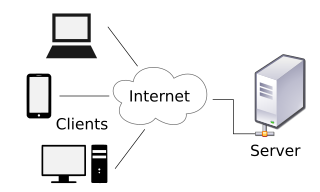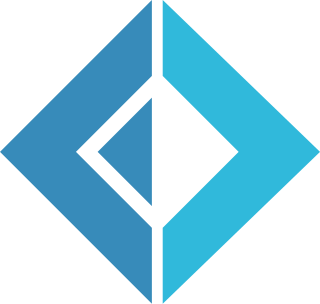Related Research Articles

The client–server model is a distributed application structure that partitions tasks or workloads between the providers of a resource or service, called servers, and service requesters, called clients. Often clients and servers communicate over a computer network on separate hardware, but both client and server may reside in the same system. A server host runs one or more server programs, which share their resources with clients. A client usually does not share any of its resources, but it requests content or service from a server. Clients, therefore, initiate communication sessions with servers, which await incoming requests. Examples of computer applications that use the client–server model are email, network printing, and the World Wide Web.
Eiffel is an object-oriented programming language designed by Bertrand Meyer and Eiffel Software. Meyer conceived the language in 1985 with the goal of increasing the reliability of commercial software development; the first version becoming available in 1986. In 2005, Eiffel became an ISO-standardized language.
A relational database (RDB) is a database based on the relational model of data, as proposed by E. F. Codd in 1970. A database management system used to maintain relational databases is a relational database management system (RDBMS). Many relational database systems are equipped with the option of using SQL for querying and updating the database.
Object–relational mapping in computer science is a programming technique for converting data between a relational database and the heap of an object-oriented programming language. This creates, in effect, a virtual object database that can be used from within the programming language.

F# is a general-purpose, high-level, strongly typed, multi-paradigm programming language that encompasses functional, imperative, and object-oriented programming methods. It is most often used as a cross-platform Common Language Infrastructure (CLI) language on .NET, but can also generate JavaScript and graphics processing unit (GPU) code.
In computer programming, especially functional programming and type theory, an algebraic data type (ADT) is a kind of composite type, i.e., a type formed by combining other types.
In computer programming, create, read, update, and delete (CRUD) are the four basic operations of persistent storage. CRUD is also sometimes used to describe user interface conventions that facilitate viewing, searching, and changing information using computer-based forms and reports.
In computer science, Linda is a coordination model that aids communication in parallel computing environments. Developed by David Gelernter, it is meant to be used alongside a full-fledged computation language like Fortran or C where Linda's role is to "create computational activities and to support communication among them".
An Internet bot, web robot, robot or simply bot, is a software application that runs automated tasks (scripts) on the Internet, usually with the intent to imitate human activity, such as messaging, on a large scale. An Internet bot plays the client role in a client–server model whereas the server role is usually played by web servers. Internet bots are able to perform simple and repetitive tasks much faster than a person could ever do. The most extensive use of bots is for web crawling, in which an automated script fetches, analyzes and files information from web servers. More than half of all web traffic is generated by bots.
The actor model in computer science is a mathematical model of concurrent computation that treats an actor as the basic building block of concurrent computation. In response to a message it receives, an actor can: make local decisions, create more actors, send more messages, and determine how to respond to the next message received. Actors may modify their own private state, but can only affect each other indirectly through messaging.
A tuple space is an implementation of the associative memory paradigm for parallel/distributed computing. It provides a repository of tuples that can be accessed concurrently. As an illustrative example, consider that there are a group of processors that produce pieces of data and a group of processors that use the data. Producers post their data as tuples in the space, and the consumers then retrieve data from the space that match a certain pattern. This is also known as the blackboard metaphor. Tuple space may be thought as a form of distributed shared memory.
A web framework (WF) or web application framework (WAF) is a software framework that is designed to support the development of web applications including web services, web resources, and web APIs. Web frameworks provide a standard way to build and deploy web applications on the World Wide Web. Web frameworks aim to automate the overhead associated with common activities performed in web development. For example, many web frameworks provide libraries for database access, templating frameworks, and session management, and they often promote code reuse. Although they often target development of dynamic web sites, they are also applicable to static websites.
Web scraping, web harvesting, or web data extraction is data scraping used for extracting data from websites. Web scraping software may directly access the World Wide Web using the Hypertext Transfer Protocol or a web browser. While web scraping can be done manually by a software user, the term typically refers to automated processes implemented using a bot or web crawler. It is a form of copying in which specific data is gathered and copied from the web, typically into a central local database or spreadsheet, for later retrieval or analysis.
A webform, web form or HTML form on a web page allows a user to enter data that is sent to a server for processing. Forms can resemble paper or database forms because web users fill out the forms using checkboxes, radio buttons, or text fields. For example, forms can be used to enter shipping or credit card data to order a product, or can be used to retrieve search results from a search engine.
In computer programming, feature-oriented programming (FOP) or feature-oriented software development (FOSD) is a programming paradigm for program generation in software product lines (SPLs) and for incremental development of programs.
Natural-language programming (NLP) is an ontology-assisted way of programming in terms of natural-language sentences, e.g. English. A structured document with Content, sections and subsections for explanations of sentences forms a NLP document, which is actually a computer program. Natural language programming is not to be mixed up with natural language interfacing or voice control where a program is first written and then communicated with through natural language using an interface added on. In NLP the functionality of a program is organised only for the definition of the meaning of sentences. For instance, NLP can be used to represent all the knowledge of an autonomous robot. Having done so, its tasks can be scripted by its users so that the robot can execute them autonomously while keeping to prescribed rules of behaviour as determined by the robot's user. Such robots are called transparent robots as their reasoning is transparent to users and this develops trust in robots. Natural language use and natural-language user interfaces include Inform 7, a natural programming language for making interactive fiction, Shakespeare, an esoteric natural programming language in the style of the plays of William Shakespeare, and Wolfram Alpha, a computational knowledge engine, using natural-language input. Some methods for program synthesis are based on natural-language programming.
Haskell is a general-purpose, statically-typed, purely functional programming language with type inference and lazy evaluation. Designed for teaching, research, and industrial applications, Haskell has pioneered a number of programming language features such as type classes, which enable type-safe operator overloading, and monadic input/output (IO). It is named after logician Haskell Curry. Haskell's main implementation is the Glasgow Haskell Compiler (GHC).
QUEL is a relational database query language, based on tuple relational calculus, with some similarities to SQL. It was created as a part of the Ingres DBMS effort at University of California, Berkeley, based on Codd's earlier suggested but not implemented Data Sub-Language ALPHA. QUEL was used for a short time in most products based on the freely available Ingres source code, most notably in an implementation called POSTQUEL supported by POSTGRES. As Oracle and DB2 gained market share in the early 1980s, most companies then supporting QUEL moved to SQL instead. QUEL continues to be available as a part of the Ingres DBMS, although no QUEL-specific language enhancements have been added for many years.
Janus is a computer programming language partially described by K. Kahn and Vijay A. Saraswat in the paper "Actors as a special case of concurrent constraint (logic) programming" in 1990. It is a concurrent constraint language without backtracking.
References
- ↑ Kahn, Ken (22–25 April 1995). "Metaphor Design - Case Study of An Animated Programming Environment" (PDF). Computer Game Developers' Conference (CGDC) Proceedings, 1995, 9th Annual World Famous. Computer Game Developers Conference. Computer Game Developers Conference. p. 241.
- ↑ Kahn, Ken (1996). "ToonTalk™—An Animated Programming Environment for Children" (PDF). Journal of Visual Languages & Computing. 7 (2): 197–217. doi:10.1006/jvlc.1996.0011. ISSN 1045-926X.
- ↑ Morgado, Leonel; Kahn, Ken (2008). "Towards a specification of the ToonTalk language" (PDF). Journal of Visual Languages and Programming. 19 (5): 574–597. doi:10.1016/j.jvlc.2007.10.002. ISSN 1045-926X. S2CID 13442755.
- ↑ Kahn, Ken (2014). "TOONTALK REBORN Re-implementing and re-conceptualising ToonTalk for the Web" (PDF). Proceedings of the Constructionism 2014 Conference. Archived from the original (PDF) on 2017-03-14. Retrieved 2016-11-18.
- ↑ Kahn, Ken (2016). Integrating programming languages with web browsers. Suksapattana Foundation. pp. 141–149. ISBN 978-616-92726-0-1.
- ↑ Kahn, Ken (2016-01-01). "A Demonstration of ToonTalk where Children Build Programs by Demonstration in a Game World". Proceedings of the 15th International Conference on Interaction Design and Children. IDC '16. New York, NY, US: ACM. pp. 676–679. doi:10.1145/2930674.2938611. ISBN 9781450343138. S2CID 19973661.
- ↑ Mikael, Kindborg (2001). Representing ToonTalk programs as comic strips. Playground International Seminar. Casa de Vilar, Porto, Portugal.
- ↑ Morgado, Leonel (2005). Framework for Computer Programming in Preschool and Kindergarten (doctoral thesis). Universidade de Trás-os-Montes e Alto Douro, Vila Real, Portugal. hdl:10348/5344. Archived from the original on Dec 7, 2022.